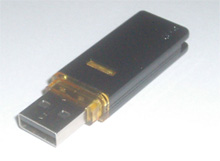How to safely re-format USB Flash Drive into NTFS
 Rohos Disk Encryption software creates hidden and protected partition on the USB flash drive. With the help of the program you may password-protect a part of your USB flash drive and open it on any computer by simply entering your password.
Rohos Disk Encryption software creates hidden and protected partition on the USB flash drive. With the help of the program you may password-protect a part of your USB flash drive and open it on any computer by simply entering your password.
Since most USB Flash drives, even the larger ones, are normally formatted with the FAT32 file system – there are limitation on the maximum size of the encrypted partition of 2 or 4 GB (max file size limitation).
In order to create a secured partition that is bigger than 2 Gb you need to change your USb stick into NTFS format.
Before changing the file system on a USB drive care should be taken to backup any critical data on it just in case the process does not work.
1. Converting the USB File System to NTFS
The simplest way to change the file system on a USB drive, especially if it already has files on it, is to convert it. This method does not delete the existing files. If the files being converted are large or many, the process might take a few minutes. Things will go alot faster if the drive is empty because you moved them temporarily to a different location.
To convert the drive follow these steps:
- Connect the USB drive to the computer and make a note of the drive letter assigned to it
- Open a command prompt by clicking on: Start > All Programs > Accessories
- At the command prompt type: CONVERT F: /FS:NTFS (where F: is your USB drive letter)
If any error messages are generated during step 3 above, this can often be taken care of by running the command: CHKDSK U: /F and then trying the convert command again. The conversion process can be verified by going to “My Computer” and checking the file system name in the properties of the drive. Trying to copy a file larger than 2 gigabytes or changing permissions on a file would also confirm that the process worked.
2. Format the USB File System as NTFS
Formatting the USB drive is definitely faster than converting it, but all files on the drive will be lost. This method is best used when the USB drive has just been purchased. Some drives have resources and tools on them at the time of purchase however, and its a good idea to protect these.
To format follow these steps:
- Connect the USB drive to the computer and make a note of the drive letter assigned to it
- Open a command prompt by clicking on: Start > All Programs > Accessories
- At the command prompt type: FORMAT U: /FS:NTFS (where U is your USB drive letter)
If there is an error message about lack of support for NTFS on the USB drive, this can be changed by going to the properties of the drive in “Device Manager”. Under the “Disk drives” section, change the properties of the USB drive “Policies” page to “Optimize for performance”.
Making the decision to change the file system on a USB drive should be done with care. Before proceeding, weigh the advantages over using FAT32, backup critical data in case the process does not work and consider compatibility issues with non-Windows operating systems.
! Please, note that it’s highly recommended to regularly (once per month) make backup of Rohos encrypted partition that is on your USB flash drive. Just make a copy of F:\_rohos\rdisk**.rdi file.
